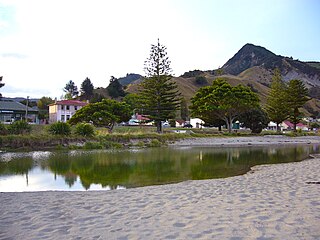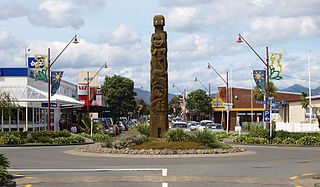
Whakatāne is a town in the eastern Bay of Plenty region in the North Island of New Zealand, 90 kilometres (56 mi) east of Tauranga and 89 kilometres (55 mi) north-east of Rotorua, at the mouth of the Whakatāne River. Whakatāne District is the encompassing territorial authority, which covers an area to the south and west of the town, excluding the enclave of Kawerau.
Edgecumbe is a town in the Bay of Plenty of the North Island of New Zealand, 15 kilometres to the west of Whakatāne and eight kilometres south of the Bay's coast.

Tokomaru Bay is a small beachside community located on the isolated East Coast of New Zealand's North Island. It is 91 km north of Gisborne, on State Highway 35, and close to Mount Hikurangi. The district was originally known as Toka-a-Namu, which refers to the abundance of sandflies. Over the years the name was altered to Tokomaru Bay.

Ōpōtiki is a small town in the eastern Bay of Plenty in the North Island of New Zealand. It houses the headquarters of the Ōpōtiki District Council and comes under the Bay of Plenty Regional Council.
Cape Runaway is the eastern extremity of the Bay of Plenty in New Zealand's North Island. It is located 90 kilometres northeast off Whakatāne and 50 kilometres west of East Cape.

Murupara is a town located in the Whakatāne District and Bay of Plenty Region of New Zealand's North Island. The town is situated in an isolated part of the region between the Kaingaroa Forest and Te Urewera protected area, on the banks of the Rangitaiki River, 65 kilometres southeast of Rotorua.
Ngongotahā is a town on the western shores of Lake Rotorua in New Zealand's North Island. It is 10 kilometers northwest of Rotorua city, and is part of the Rotorua metropolitan area. Its population was 4,107 in the 2013 census.

Ōmokoroa is a small urban area in the Western Bay of Plenty District of New Zealand. The suburb is considered part of Greater Tauranga, and is within the Coromandel electorate. Ōmokoroa began as a small rural holiday village, but is expanding to be a commuter town, with a 25-minute drive to Tauranga City.

Taneatua is a small town in the Bay of Plenty region of New Zealand's North Island. The town is located southeast of Pekatahi, a similarly small settlement; Whakatāne is the nearest significantly sized town. Just to the southwest of Taneatua, the Whakatane River and Waimana Rivers meet. The Whakatane River itself flows to the west of Taneatua, while the Waimana River is south of the township.
Te Teko is a small inland town along the banks of the Rangitaiki River in the Bay of Plenty region of New Zealand's North Island.

Frasertown is a small settlement in the northern Hawke's Bay Region of New Zealand's eastern North Island.

Pukehina is a beach and township located in the Western Bay of Plenty District and Bay of Plenty Region of New Zealand's North Island. It consists of a white sandy beach, an estuary, farms and several homes. The area is popular with surfing, windsurfing and kite surfing. There is a campground located at the south-eastern end of the beach, and a boat ramp at the estuary.
Waimana is a rural valley in the Whakatāne District and Bay of Plenty Region of New Zealand's North Island. It is located in the northern Urewera. Waimana River, originally known as Tauranga River, runs through the valley, joining the Ohinemataroa River one kilometre south-west of the Tāneatua.

Coastlands is a beach settlement in the Whakatāne District and Bay of Plenty Region of New Zealand's North Island. It is located north of Whakatāne, directly across the Whakatāne River.
Maungatapu is a suburb and peninsula of Tauranga in the Bay of Plenty region of New Zealand's North Island. It is north-east of Hairini and south-east of Matapihi.
Matapihi is a suburb and peninsula of Tauranga in the Bay of Plenty region of New Zealand's North Island, surrounded on most sides by the Tauranga Harbour.
Mayfair is a suburb of Hastings City, in the Hawke's Bay Region of New Zealand's North Island.
Mangakakahi is a suburb of Rotorua in the Bay of Plenty Region of New Zealand's North Island.
Selwyn Heights is a suburb of Rotorua in the Bay of Plenty Region of New Zealand's North Island.
Utuhina is a suburb of Rotorua in the Bay of Plenty Region of New Zealand's North Island.










